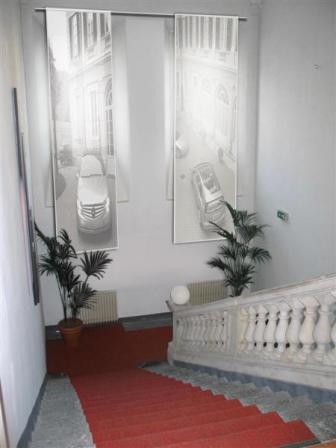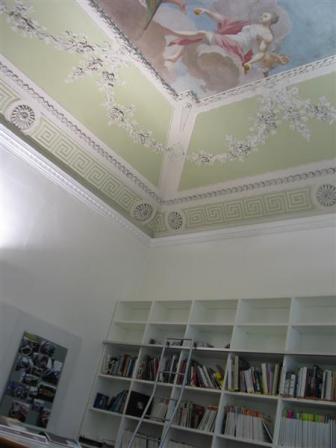
Mercedes-Benz opened the Advanced Design Studio in Como/Italy in February 1998. The choice of location was deliberate, since as a source of inspiration in areas ranging from culture and lifestyle to design, fashion and architecture, southern Europe is second to none. This inspiration is crucial to developing interior design concepts for vehicles – and this is what the Advanced Design Studio in Como has specialized in.
“Looking back, the Mercedes-Benz Advanced Design Studio in Como has proved a success story,” said Peter Pfeiffer, head of Design at Mercedes-Benz, at an event in 2008 to mark the tenth anniversary of the studio’s opening. “This is where important interior design concepts are developed as ‘idea generators’ for the cars of the future. But Italy is also a direct source of ideas for Mercedes-Benz production vehicles.”
Along with Irvine/USA and Yokohama/Japan, Como was the location chosen for the company’s third Advanced Design Studio. All three have the same objective: “Our goal is to try to predict social trends as far into the future as possible,” explained Pfeiffer. “In the ideal scenario, we would be setting these trends ourselves, since our aim is to create the world’s most desirable car in the eyes of each of our customers.”
New concepts require a feeling of space and inspiration. “That’s why for the Advanced Design Studio we needed a place where we could get on the trail of interior design trends of the future,” recalls Mercedes-Benz designer Hans-Harald Hanson, the man now in charge of strategic design concepts in Sindelfingen. He developed the studio in Como, with all the aspects of planning and administration that entailed, and for the first two years was its director. Northern Italy is particularly well suited as a barometer for top-quality lifestyle ideas. “The Como-Milan-Turin triangle is home to the furniture and fashion industry,” says Hanson, explaining the reasons behind the choice of location. “Accordingly, high value is placed on traditional craft – making it an ideal environment for the Advanced Design Studio.” And there was another significant reason for selecting Como: Italy is one of the biggest markets for sales of “La Mercedes” – as the vehicles are more familiarly known.
The search for suitable premises got underway in June 1997. This would prove less than straightforward, however, since the building not only had to accommodate 15 to 20 designers, modelers, interior designers and engineers, all striving to give interior value to the cars of the future in a pleasant and work-conducive environment. There also had to be enough room to house full-sized vehicles, which meant, for example, wide doors and strong floors.
The choice finally fell on Villa Salazar, situated close to the banks of Lake Como, and at one time a production facility for Italian fashion designer Gianni Versace’s neckties and cravats. Indeed, reliable sources suggest that many of his designs were inspired by the frescoes that today still decorate the walls and ceilings of the villa which dates from around 1750.
Today Hanson is as enthusiastic as ever about the premises: “We made an excellent choice with the studio. In structural terms the villa is state-of-the-art. And with its contemporary painted ceilings, long suites of rooms and contrasting floors of terracotta and wood, the studio’s flair is extraordinarily inspirational.”
The creative designers in Como cover a broad range of tasks. They do general research, work on design drafts and build models – all the while attempting to look over the horizon in an effort to develop the car interior of the future. If they are to develop new approaches, it is a job that calls for a certain lack of respect towards tradition and convention. But it is essential to maintain at all costs those characteristics that typify a Mercedes-Benz, such as elegance, dynamism and quality: “Naturally brand-specific requirements have to be taken into account,” said former head of Design Bruno Sacco when defining the role of the Advanced Design Studio at the Turin Motor Show in April 1998. “But each project also has to be seen from a long-term perspective which, while remaining in line with our design strategy and its ongoing development, describes the design characteristics of our Mercedes vehicles.”
Unlike the exterior design of a car, interior design is not first and foremost about putting a beautiful sculpture on the road. “In interior design the focus is always on the human being. So what interests us, for example, are questions about how the customer sits in the car and the sensations he would like to have or ought to experience when driving,” explains Hans-Harald Hanson. In addition to structural specifications, which make the interior environment practical and user-friendly, the designer is obliged to use all the senses. So appearance plays an important role but so too do smell, acoustics and touch, if one is to feel completely at home in one’s “driving environment”. Occasionally the design of a switch or a vent can make a considerable difference – not least in terms of brand identity: “Design embodies the values of a company,” says Peter Pfeiffer. “Even if there were no star, the car must always be recognizable as a Mercedes-Benz.”
But how does one reveal the future of the interior in Como? To this day, the designers there have been collecting all sorts of objects that may one day come in useful. These include handcrafted products from the region as well as high-tech components from nanotechnology or bionics, for instance. “At first sight, many of the things we collect don’t have any obvious application in a car,” says Hanson. “But technology is making enormous progress. What is impossible today may be just the thing in the car of tomorrow.” The designer cites granite as an example. At one time it would have been unthinkable to use this unyielding material to design the contoured, three-dimensional surfaces required for a vehicle interior. Today it is possible to apply an extremely thin coat of genuine granite to the surfaces – already available in the Mercedes-Benz designo program.
It is a job that demands great patience of the hard-working aesthetes. It can take several years before the germ of an interior design idea is finally implemented in a vehicle. The interior of the Mercedes-Benz F 400 Carving research vehicle – first unveiled to the public in Tokyo in 2001 – was one of the Advanced Design Studio’s first tangible results. Then in Detroit in 2002 came the Vision GST, a precursor of the Mercedes-Benz R-Class, followed in Tokyo in 2003 by the F 500 Mind research car. In Washington in 2005 the public was given its first glimpse of the Mercedes-Benz bionic car, and that same year, once again in Tokyo, the company presented the F 600 HYGENIUS research car in which the designers combined the classic materials of wood and leather with a luminescent yellow plastic gel to add lively color highlights to the seats and footwells. In the Mercedes-Benz F 700 research car presented in 2007, on the other hand, the emphasis was on cork and ultrasuede.
Northern Italy even witnessed the launch of a limited-edition, high-quality vehicle series when in 2003 – with the active support of the Advanced Design Studio in Como – fashion designer Giorgio Armani created the exclusive “Mercedes-Benz CLK designo by Giorgio Armani”. The suitably refined Mercedes-Benz CLK 500 convertible was built in a limited edition of 100 units. Armani took his inspiration for his color and material design from the legendary handcrafted classic cars of old; like the Mercedes-Benz designers working in Northern Italy, he too selected materials from his familiar environment and combined them to form a new and unusual overall experience.
“The aspects of our work at the Design Studio have shifted somewhat since the early years,” observes Hans-Harald Hanson. “To begin with our primary goal was to develop Como as a think tank – a place where designers could find the inspiration to think the unthinkable. Nowadays, the studio’s expertise is used extensively in the design of production cars.” Hanson sees no harm in this development, however. On the contrary, design ideas from Como have found their way into no less prestigious a series than the current Mercedes-Benz S-Class.






























